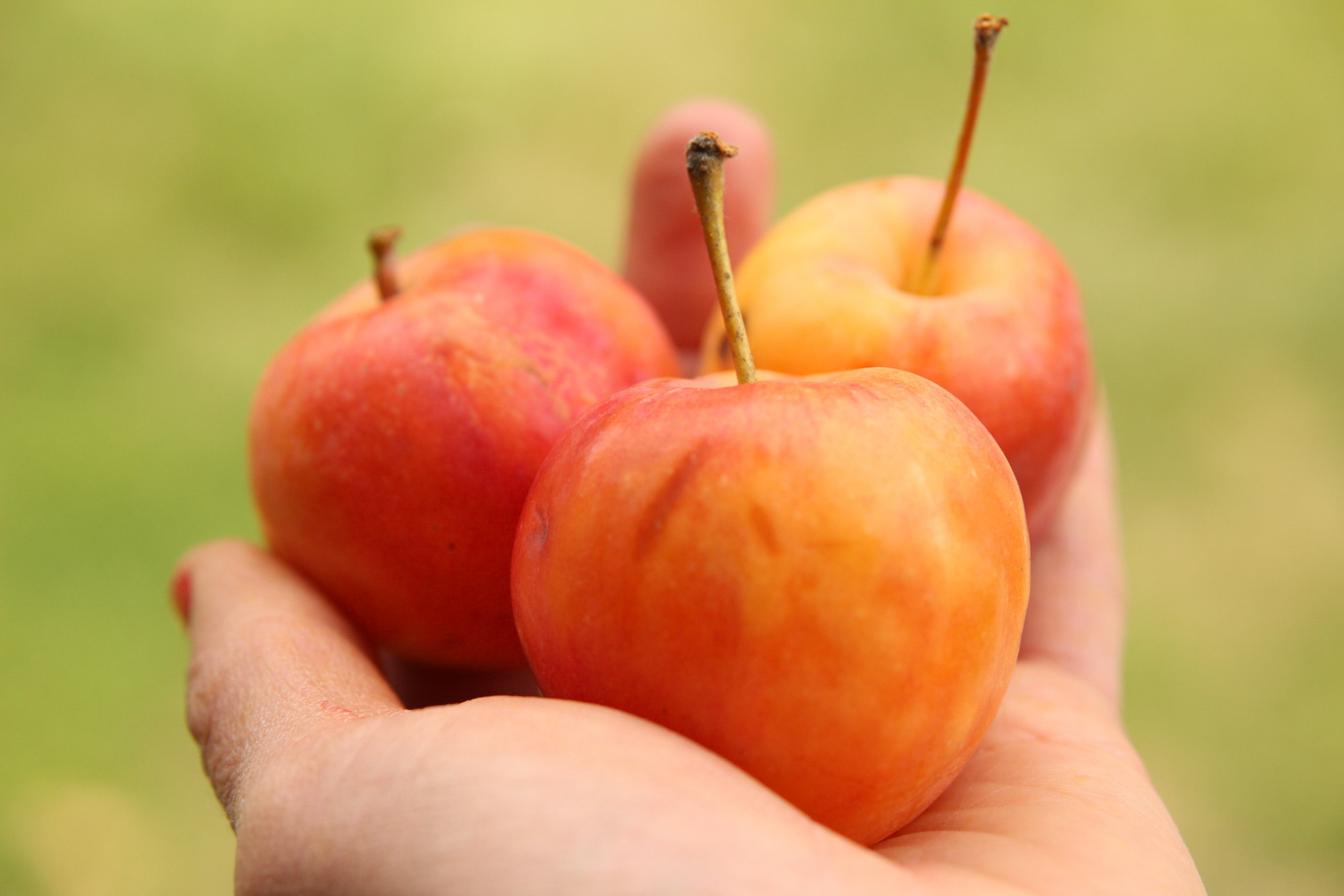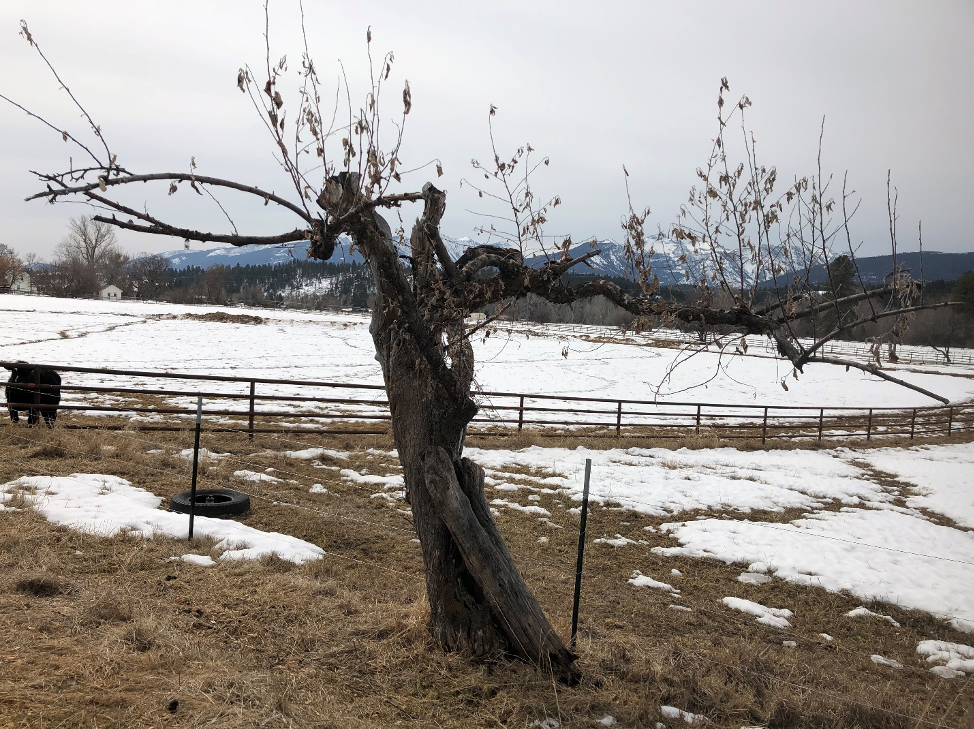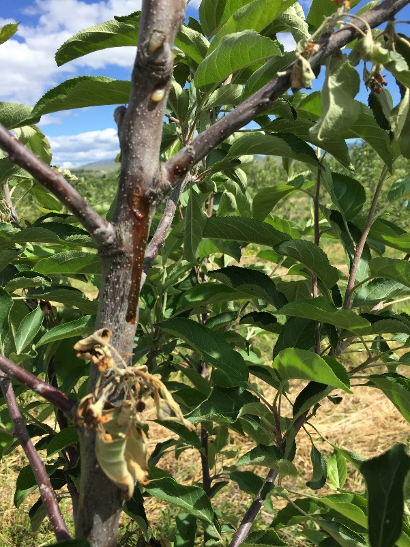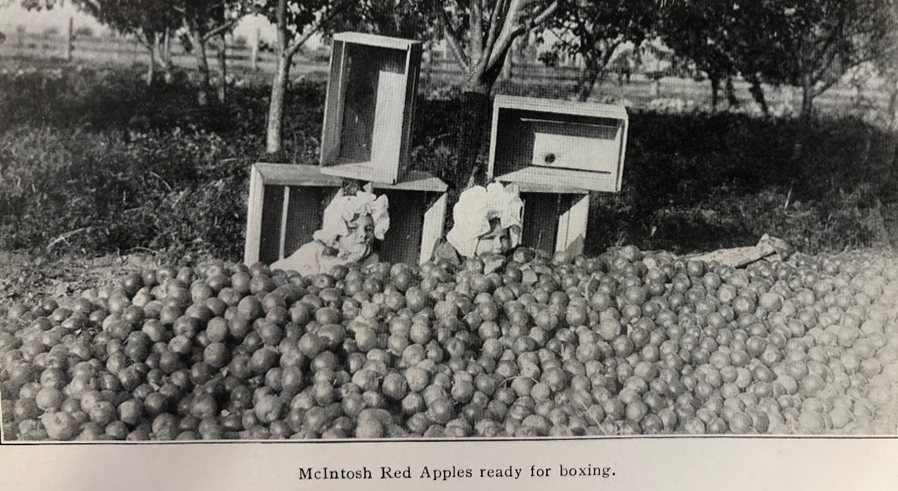Harvesting Quality Fruit

A lovely handful of Transcendent Crabapples!
The ideal end result of a well-maintained orchard is sweet, colorful, worm-free fruit. It is often the main motivation behind all the hard work of maintaining any orchard. Quality fruit requires not only proper irrigation, fertility management, and honed pruning skills, but also diligent fruit thinning and proactive pest management.
During Montana’s apple boom, Montana growers were producing award-winning fruit alongside well-established competitors in Washington and New York State. At the St. Louis Exposition in 1904, the Bass Brothers, pioneer orchardists credited with planting Montana’s first commercial orchard in 1871, were awarded a gold medal for their Bitterroot-grown apples (RR, 9/17/1997, 5). At the Panama-Pacific International Exposition, Montana’s display was awarded Grand Prize!1 While Montana had originally been touted as “The Land of the McIntosh Red,” where “the apple you could eat in the dark” was grown by the plenty, by the turn of the century, codling moth and fire blight had quickly become menacing pests for orchardists across the state, resulting in the removal of large swaths of infected trees and even whole orchards.

Montana Exhibit at the National Apple Show at Spokane, WA. Winning third prize in carload lot. 9th Annual Session of the Montana Horticultural Society, January 24-26, 1906. Montana Historical Society Archives.
Thinning Fruit
Today, as then, to effectively grow quality fruit and enjoy annual harvests, your tree's fruit should be thinned on a yearly basis. Thinning not only results in larger fruit at harvest, it also reduces the number and ratio of fruit injured by codling moths. Additionally, apples are often biennially bearing, meaning the tree yields a heavy crop one year and very little (if at all) the next year. Thinning helps ensure your tree will yield an apple crop each year, rather than every other.
To thin fruit, simply remove all but 1-2 of the largest fruit from clusters when the fruit are about marble size. Fruit clusters should be spaced about 6 inches apart, and fruit within clusters should not be touching to help reduce codling moth damage. On large trees this task may seem overwhelming and it is one of the many reasons dwarf rootstock has become so popular, but remember, early orchardists understood the importance of thinning fruit outweighed the tedium. Amos Estley of Big Fork wrote in 1906, “This part of growing is often neglected as it is considered tedious work, but it is suprising how much a nimble hand can do in a day…if you thin a little too severely (which is just right), the growth will go into the tree insuring larger crops hereafter, you will see that in the future you are the gainer.”
In addition to thinning, orchardists must manage pests. For the heritage orchardist, this can seem like a daunting endeavor in their towering trees where little equipment is available for safe application of chemicals. There are, however, several ways to approach management of Montana's most common pests — codling moth and fire blight — without ever reaching for a spray nozzle.
Montana Apple Pests
One advantage to growing apples in Montana is the relatively short list of apple pests that can be detrimental to fruit and trees. The primary pests include codling moth and fireblight which can severly damage a crop or quickly kill young trees. These pests should be controlled through an Integrated Pest Management (IPM). Other common orchard pests in heritage orchards include eriophyid mites, aphids, leaf rollers and an assortment of other insects rarely harmful to fruit and often kept under control with good irrigation management. For a more detailed description of Montana fruit pests go the the Pest section of the Montana Apple Growing Guide.
Codling Moth
For a full description of this pest and its management in Montana, visit Montana State University's guide for Managing Codling Moth in Montana Home Orchards. You can also visit Colorado State University's guide for Codling Moth Control in Home Plantings, which details options for non-chemical controls of codling moth.
Codling moth can be controlled in many ways without spraying pesticides. The first steps you can take toward decreasing the number of codling moths in your orchard are thinning fruit, as mentioned above, and practicing good sanitation in orchards. In Montana, codling moths typically achieve two to three generations of offspring per season. Their larvae feed inside the tree's fruit before exiting to pupate in bark and soil. Dropped fruit, which often contains these codling moth larvae, should therefore be removed from the orchard as regularly as possible throughout the season. Dropped fruit should not be left on the ground over winter. Another method for discouraging the development of codling moth larvae in fruit is to band the trunk with corrugated cardboard or burlap. This reduces the number of codling moths by encouraging them to pupate in the removable cardboard instead of the tree's bark. For a full description of tree banding, visit Codling Moth Control in Home Plantings.
Fruit can also be individually bagged with paper or plastic bags, or even panty hose. WARC is currently researching the best materials and timing for bagging fruit, however, research last year indicated that plastic bags are not ideal, as they retain moisture and can house earwigs. Paper bags, like those used for sack lunches, have been suggested by CSU in their Codling Moth Control in Home Plantings publication and can be applied when fruit are ½-1-inch in diameter.
Fire Blight
For a full description of the fire blight pathogen and its management, visit Montana State University's visit Fire Blight Management in Montana Orchards.

Fire blight in a heritage apple tree. New growth is particularly susceptible to fire blight infection and spread.
Fire blight is a serious pathogen of plants in the Rosacea family, to which both pears and apples belong. It tends to be a larger threat to young trees, traveling most quickly in vigorous, vegetative wood. Late-blooming cultivars can also be more susceptible to infection, as the pathogen’s presence, along with warm temperatures which feed its growth, increase through bloom. In older trees, infection is usually limited to younger wood. Many heritage fruit trees, despite their age, are fire blight susceptible cultivars, and they should be managed to reduce infection.
The images below show what a fire blight infection can look like on apple trees. Initial infection in blossoms cause the flowers to shrivel and turn brown or black. Overwintering cankers will begin to ooze as temperatures increase in the spring (below left) as the disease spreads shoots will appear to suddenly die appearing scorched and tips of branches bend forming the characteristic “shepherd’s crook” on the right.


Following these basic rules for orchard management will reduce your trees’ susceptibility to fire blight:
- Do not spray water into the tree canopy, especially during bloom. Fire blight infection usually occurs in the spring during bloom, most often when a rain event is followed by a warm day. If the pathogen is already present, it can also be spread via spraying water, even after bloom.
- Do not over-fertilize trees with nitrogen. This leads to increased vegetative growth and therefore the spread of the pathogen.
- Prune out infected shoots and limbs. This can be done at any point in the season when an infection is noticed. During the growing season, infected material should be pruned at least 18 inches below the point of infection. In the winter when trees and the disease are dormant, cankers can be removed at the next horticulturally appropriate point below infection. Do not aggressively prune trees (including fire blight infected material) after July as this can spur vegetative growth and slow the tree from going into dormancy. Wait until winter pruning to remove these late season infections.
Knowing When to Harvest Fruit
There can be several indicators for ripe fruit, and the exact timing will vary from year to year based on growing conditions. For most fruit, seeds will begin to darken and the exterior of the apple will begin to color from green to its cultivar specific coloration. Some growers will use a starch-iodine test, where fruit is halved and sprayed with an iodine solution. The iodine colors starches black while sugars remain unchanged. For more information on using this test in Montana orchards, visit Montana Statue University's Apple Cultivar Maturity at WARC Fall 2019.

PHOTO: “McIntosh Red Apples ready for boxing” in The Bitterroot Valley: The Land of the McIntosh Red. The Board of the County Commissioners of Ravalli County. 1908.
Below is a chart of approximate bloom times, harvest dates, and fire blight susceptibility for common heritage apples grown in Montana.
|
Cultivar
|
Bloom
|
Harvest
|
Fire Blight Susceptibility*
|
|---|---|---|---|
|
Alexander
|
Mid May
|
Mid season
|
Moderate
|
|
Duchess of Oldenburg
|
Mid May
|
Late August to early September
|
Minimal to moderate
|
|
Fameuse/Snow
|
Early to mid season
|
Early October
|
Moderate
|
|
Haralson
|
Mid season
|
Late season
|
Minimal
|
|
Hibernal
|
Early season
|
Late season
|
Minimal
|
|
Lodi
|
Early season
|
Late August to early September
|
Severe
|
|
McIntosh
|
Early to mid season
|
Mid to late September
|
Moderate
|
|
Northwest Greening
|
Mid season
|
Late September
|
Severe
|
|
Northern Spy
|
Late season
|
Late October to early November
|
Severe
|
|
Patten Greening
|
Mid season
|
Late season
|
Minimal to moderate
|
|
Transcendent Crab
|
Early season
|
Late summer to fall
|
Severe
|
|
Wealthy
|
Mid May
|
Late September
|
Minimal to moderate
|
|
Whitney Crab
|
Early season
|
Late August to early September
|
Severe
|
|
Wolf River
|
Mid May
|
Mid October
|
Minimal to moderate
|
|
Yellow Transparent
|
Early to mid season
|
Early to mid season
|
Severe
|
*In this table, fire blight susceptibility is measured as minimal, moderate, or severe.

